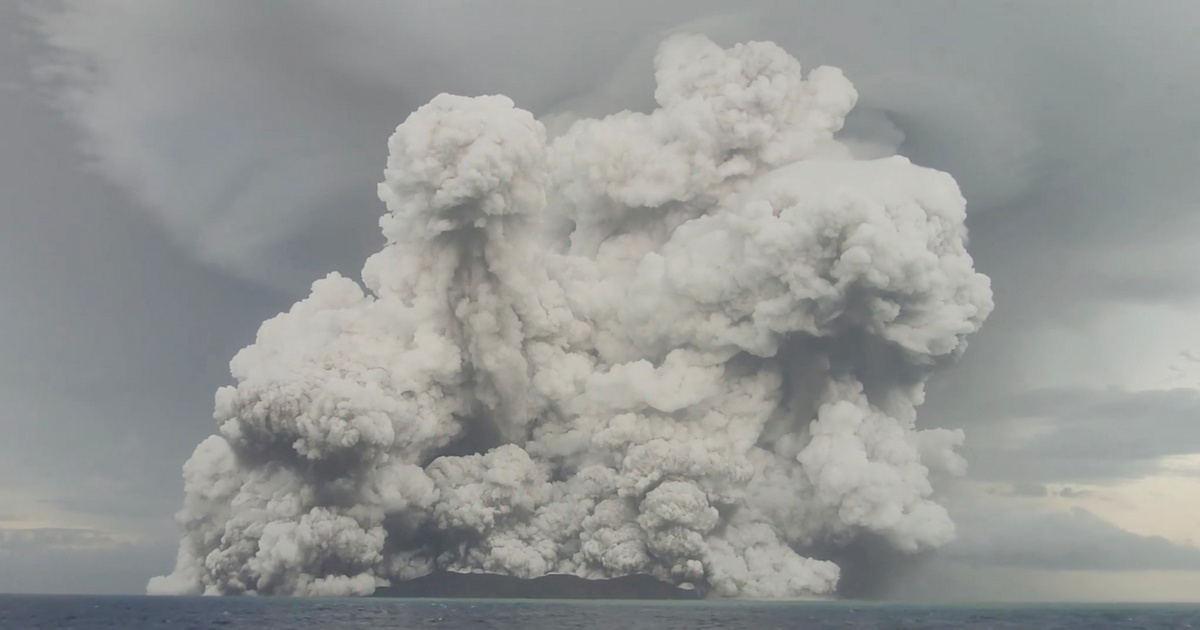On Saturday afternoon January 15th local time (early morning Hungarian time) there was a huge explosion broke out Hunga Ha’apai-Hunga is a volcano located in the Tonga Islands.
There are two small volcanic islands in the Pacific Ocean in the past month many times A volcanic eruption rocked the island of Honga Tonga and Honga Hapai, as it was constantly shifting and merging. Although these are small islands, they are notable parts of a larger underwater volcano.
The islands of Hunga Tonga and Hunga Ha’apai are part of a huge underwater volcano, say the outcrops. Under the water, from a base, there is a volcano with a height of about 1,800 meters and a diameter of 20 kilometers, and inside it is a depression with a diameter of 6 kilometers, that is, a caldera.
Explained at our request Doctor. Czabulex Harangi Geologist-volcanologist, corresponding member of the Hungarian Academy of Sciences, director of the institute, professor, head of the research group. The volcano in question has structural sections where small eruptions can form islands at the edge of the caldera. Then comes a larger eruption that shrinks in size and the reflux disappears.
The volcanologist explained that it is still difficult to determine whether another eruption is expected after January 15. There was a shorter eruption in 2015 that connected the two islands, and that eruption renewed on December 20 last year. After a short break, two major outbreaks occurred on January 14 and 15 this year, according to the institute’s director.
It can’t be said there won’t be a sequel, but there’s no news yet of another outbreak.
The volcanic eruption system was nearly activated nearly a thousand years later, resulting in another major eruption, which may have ruptured the surface (caldera), which is also attributed to a tsunami from the area. Szabolcs Harangi personally suspect that a rearrangement of the underwater mass – which can also be called a rupture – led to the tsunami, which was amplified by the atmospheric pressure wave. However, there is no confirmed information about the rupture yet, to obtain such data, a quieter operation of the volcano is needed.
According to the expert, there is a greater chance of more eruptions in the future than complete calm, but he stresses that there is no useful monitoring, so they cannot rely on signs of earthquakes, surface changes and gases.
When asked why the volcanic eruption was so large, Harangi said the explanation given by New Zealand volcanologists was likely likely.
Over a good thousand years, intermittent magma charges, magma mixtures, crystallization, and precipitation of gases resulted in larger amounts of magma capable of pushing to the surface. When it reaches the surface under water, it mixes with ocean water in shallow water depths, and this may have increased the power of the volcanic eruption. If there was no water, any volcanic eruption on Earth, it would probably still be big
The expert explained.
Because it is a remote location in the middle of the ocean, more than two thousand kilometers from New Zealand, they do not know how much volcanic material appeared on the surface, which also determines the strength of a volcanic eruption. As a result of the outbreak, the surrounding communication channels have been cut off, a BBC article According to the cables laid at the bottom of the sea, they were also damaged, and two weeks were expected to be repaired. The volcanic potion came largely in the ocean, under the water.
The eruption can also be seen through satellite images, the cloud of the volcanic eruption reached a height of about 20 kilometers, the sound of the explosion was heard at a distance of two thousand kilometers from the island, and the air pressure changed. Also in Europe conceivable. the With the eruption of the Krakatau volcano in 1883 Comparing what happened in the Tonga Islands: There are similarities between the two phenomena, but there are also significant differences.
Both were underwater eruptions, a tsunami associated with both, and an atmospheric pressure wave after a major sonic effect, but the 1883 Krakatau eruption was much larger.
Harangi said.
In the smoke cloud that reached the stratosphere, a lot of lightning was recorded in two hours in one hour, which can be considered a record.
Lightning strikes in volcanic ash clouds because many tiny grains less than a millimeter in size circulate in the eruption cloud. Particles of different charges collide with each other, so they are electrically charged and then separated and discharged. However, in this case, the fact that there were a lot of ice particles in the volcanic cloud also contributed to the lightning. This is due to the mixing of magma with water. Water vapor droplets entering the eruption cloud suddenly cool into high-altitude particles, and collision with them increases the chance of lightning
– explained the expert who said that thanks to the space sensors they obtained information almost instantly, and To the fireworks blog page They were also able to broadcast outbreak events in near real time.
Satellite data can also be relied on for eruption cloud formation. According to the data so far, 400,000 tons of sulfur dioxide have entered the stratosphere, which is far from the minimum 3-5 million tons that will have a noticeable impact. There is no data yet on how much carbon dioxide has been released into the air, but Harangi makes it unlikely that it was very high and would not affect the climate. Regarding the effect of sulfur dioxide, the expert expects only a small degree of cooling-climate effect, which can only be detected in an efficient way, and has clearly stated that
There will be no direct consequences of the outbreak in Hungary.
(Cover Photo: An underwater volcano erupts near Tonga in the South Pacific on January 14, 2022. Photo: Geological services in Tonga / Reuters)












































